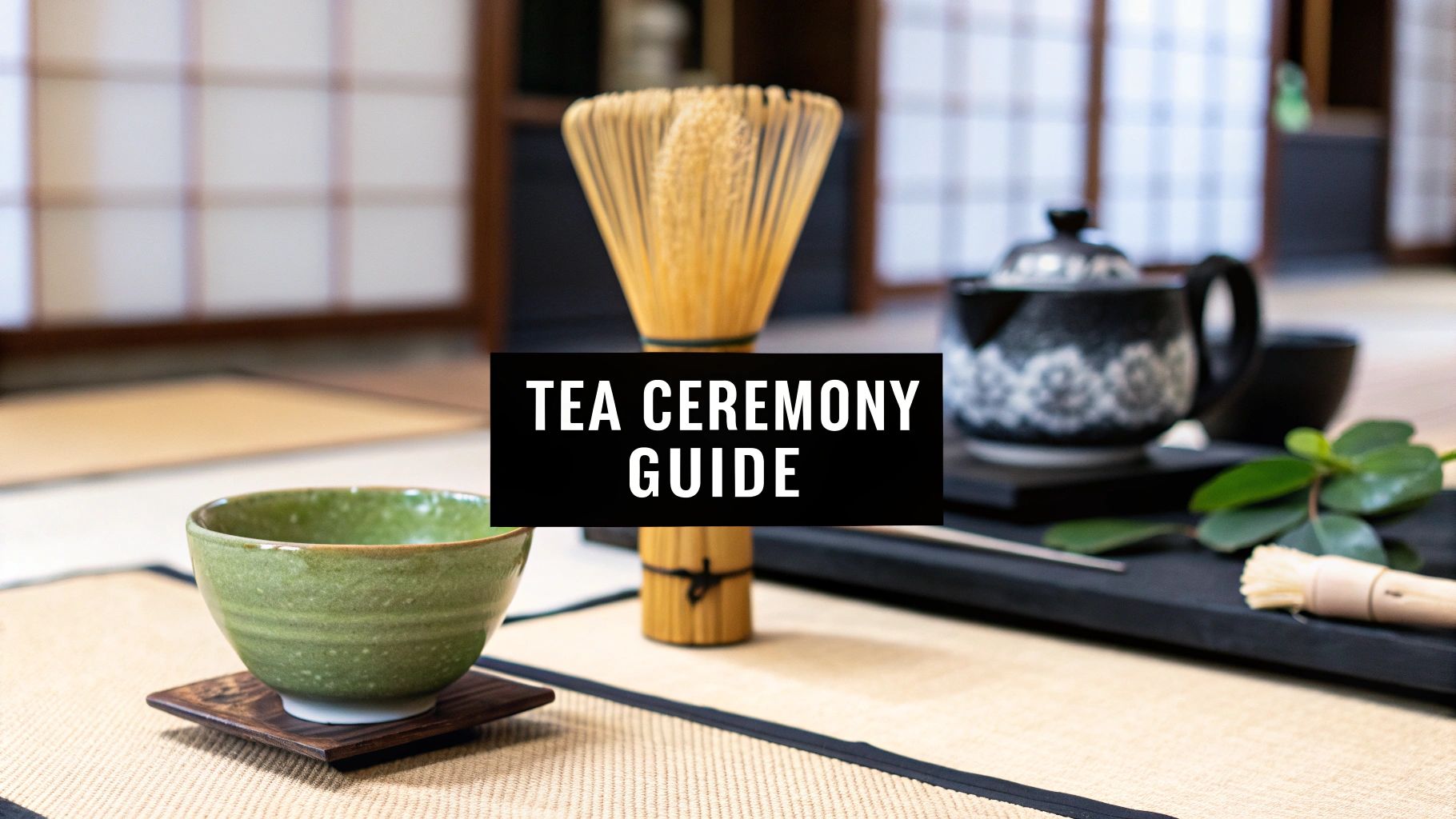The traditional Japanese tea ceremony, known as Chadō or 'The Way of Tea,' is a centuries-old spiritual discipline and a beautiful, intricate art form. It’s far more than just a way to serve a drink; it’s a profound expression of hospitality where every gesture, every tool, and every step is carefully chosen to create an experience of total tranquility and mindfulness.
The Soul of the Tea Ceremony

At its heart, the Japanese tea ceremony is a spiritual process. The whole point is to foster a deep sense of presence and connection between the host and their guests. You can think of it less as a performance and more as a shared journey into mindfulness, guided by principles that have been polished over generations.
The entire ritual is designed to pull your awareness into the present. From the quiet shuffle of feet on tatami mats to the gentle sound of hot water being ladled into the tea bowl, every detail is part of a purposeful and graceful dance. This isn't about rushing a caffeine hit; it's about deliberately slowing down to find beauty in simplicity.
The Four Guiding Principles
To truly get the tea ceremony, you need to understand the four core ideas set down by the tea masters of old. These principles are the pillars that support the unique atmosphere of the ceremony, turning a simple get-together into something much deeper.
- Harmony (和, Wa): This is all about creating a feeling of unity. It’s the seamless blend of nature outside, the chosen tea utensils inside, and the people in the room, all coming together to create a sense of peace.
- Respect (敬, Kei): Respect is shown by everyone, for everything. Guests respect the host, the host respects the guests, and everyone shows reverence for the tea utensils and the tea itself. This is seen in the humble bow and the careful handling of the tea bowl.
- Purity (清, Sei): This concept is both physical and spiritual. The tea room is spotless, and guests symbolically cleanse themselves by washing their hands before entering. This outer cleanliness is a reflection of the desired inner purity of heart and mind.
- Tranquility (寂, Jaku): This is the ultimate goal. When harmony, respect, and purity come together, a state of profound calm and tranquility can finally be realised. It's in this peaceful state that you can truly appreciate the moment for what it is.
The Way of Tea isn’t just about the tea; it’s about the whole aesthetic experience. The host’s main goal is to make their guests feel welcomed, connected to the season, and completely immersed in a moment of shared serenity.
Why Every Gesture Matters
In a traditional Japanese tea ceremony, no movement is accidental. The host’s graceful preparations, known as temae, are a kind of moving meditation. Every scoop of matcha powder, every pour of water, and every whisk of the tea is performed with deliberate intention. This isn't just for show; this precision communicates deep respect and care, inviting guests to slow their own minds and focus their attention.
This focus on quality naturally extends to the tea itself. Using the right grade of matcha is absolutely critical, as its flavour and texture are the centrepiece of the whole ritual. That vibrant green colour and rich umami taste of a top-tier matcha are precisely what guests are meant to savour. For anyone wanting to bring this authentic experience home, choosing the best matcha in the UK is a vital first step.
Ultimately, the ceremony teaches a powerful lesson: to find beauty in simple, fleeting moments—a philosophy that feels more relevant today than ever before.
The History and Philosophy of The Way of Tea
The story of the traditional Japanese tea ceremony, known as Chadō or "The Way of Tea," doesn't begin with an elaborate ritual, but with a handful of humble tea seeds. Buddhist monks first carried tea to Japan from China way back in the Nara Period (710-794 AD). At first, it was prized mostly by monks and nobles for its medicinal benefits—it was fantastic for staying alert during long hours of meditation.
It wasn't until the Kamakura Period (1185-1333) that the practice of grinding tea leaves into a fine powder—what we now recognise as an early form of matcha—really took hold. This method, also a Chinese import, started to shift tea's role from a simple health tonic to a key part of religious life in Zen monasteries.
From Samurai Pastime to Spiritual Path
As tea became more popular, it inevitably caught the eye of the powerful samurai class. They developed a taste for it, but in their own unique way. They started hosting flashy tea-tasting contests called tōcha, where guests would try to win extravagant prizes by guessing the origins of different teas. These gatherings were less about quiet reflection and more about showing off wealth and social standing.
But a change was in the air. A new way of thinking started to bubble up, one that turned away from the gold-plated extravagance and towards something more refined and spiritual. This shift slowly laid the foundations for the ceremony we know today.
A key figure in this evolution was Murata Jukō (1423-1502), who many now call the father of the tea ceremony. He introduced the concept of wabicha, a style that celebrated rustic simplicity over showy, imported luxury. Jukō championed locally made, unpretentious Japanese pottery and simple bamboo tools, making the practice more about inner focus than outward display.
The Influence of Sen no Rikyū
The philosophy of wabicha was truly perfected by the most revered figure in the history of tea, Sen no Rikyū (1522-1591). While serving as a tea master to some of Japan's most powerful warlords, Rikyū refined the ceremony, weaving in the principles of wabi-sabi—the deep appreciation for the beauty found in imperfection, impermanence, and simplicity.
Sen no Rikyū believed that true beauty lay not in expensive materials but in the quiet harmony between the host, the guests, and nature. He taught that a simple, cracked bowl, if chosen with care and presented with sincerity, was more valuable than a flawless piece of gold.
Rikyū made several key changes that defined the intimate and humble character of the ceremony. He popularised smaller, more rustic tea rooms and introduced the nijiriguchi, or "crawling-in entrance." This tiny doorway forced everyone, from the highest-ranking samurai to the commoner, to bow low to enter. It was a powerful act, symbolically leaving one's ego and status at the door. In the rigid social structure of feudal Japan, this was a radical move, creating a rare space of pure equality.
While powdered green tea had been around for centuries, it was Rikyū who truly cemented matcha's central role in this newly defined spiritual practice. If you're curious about what makes it so special, you can explore the differences between pure matcha and standard green tea to understand its unique properties.
Preserving the Tradition Through Major Schools
After Rikyū’s death, his descendants carried his teachings forward, eventually establishing the three main schools of tea ceremony that continue to this day:
- Urasenke: The "back house" school, known for being more accessible and for its proactive efforts to share the Way of Tea around the world.
- Omotesenke: The "front house" school, which tends to stick to more traditional and reserved practices.
- Mushanokōjisenke: A smaller but distinct school that maintains its own unique traditions and style.
These schools have carefully preserved Rikyū's legacy for hundreds of years, making sure that the core spirit of harmony, respect, purity, and tranquillity lives on. Rikyū’s philosophy even found a receptive audience in the UK, where it resonated with artists and intellectuals in the early 20th century. This fascination led the Urasenke Foundation to open a London branch in 1978. Since then, it has held over 500 classes, and attendance at UK tea ceremonies soared by nearly 300% between the 1960s and 1980s. You can discover more insights about this cultural exchange on byfood.com.
Exploring the Essential Tools of the Ceremony
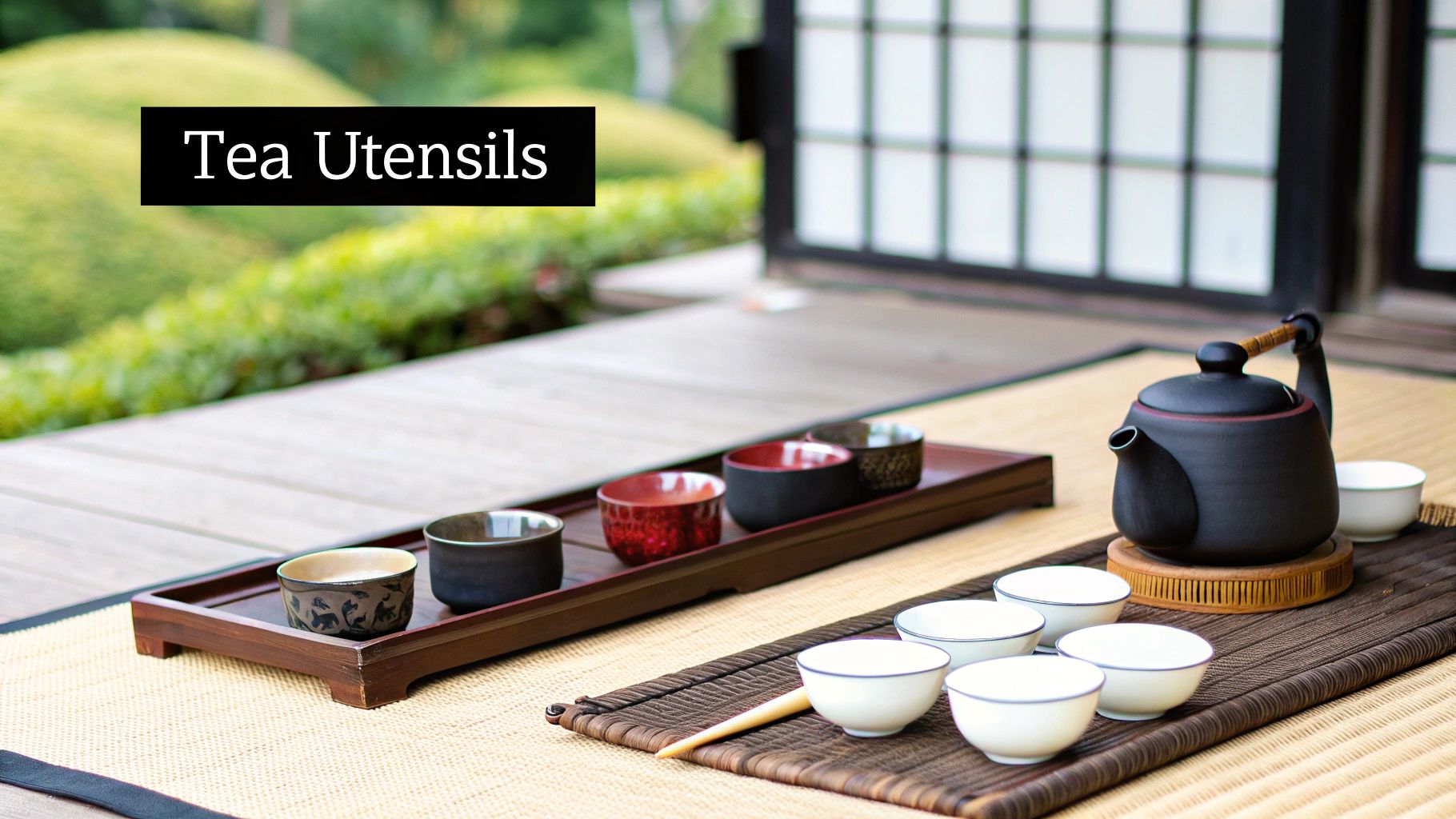
In a traditional Japanese tea ceremony, the tools, known as dōgu, are far more than just utensils. Each object is a character in the story of the gathering, chosen with deep intention and handled with the utmost respect. They aren't merely functional; they are vessels of artistry, history, and the quiet philosophy of wabi-sabi.
Think of these tools as extensions of the host's spirit. Every piece, from the humble bamboo scoop to the artfully crafted tea bowl, helps shape the ceremony’s atmosphere of mindful presence. To truly appreciate the depth of this beautiful ritual, you have to understand the role each one plays.
These are not just objects for making tea; they are carefully selected to reflect the season, the occasion, and the unique connection between the host and their guests.
The Chawan (Tea Bowl)
The Chawan (茶碗), or tea bowl, is arguably the most personal and expressive tool in the ceremony. It’s the vessel from which the guest receives the tea, making the link between host and guest tangible. Bowls are chosen for their shape, glaze, and even their subtle imperfections, which are seen as part of their character.
For example, a summer bowl is often wide and shallow, a clever design that allows the tea to cool more quickly in the heat. Winter bowls, on the other hand, are typically deeper and more cylindrical, helping to conserve warmth. The texture and glaze of the Chawan are meant to be enjoyed not just by sight, but by touch as the guest cradles it in their hands.
A cherished Chawan often carries its own history. Subtle cracks or repairs aren't hidden but celebrated as part of its journey. This embodies the wabi-sabi spirit—finding profound beauty in the marks of time and use.
The host selects a bowl they feel will resonate with their guests, making its choice an act of deep consideration and hospitality.
The Chasen (Bamboo Whisk)
The Chasen (茶筅) is the delicate bamboo whisk used to combine powdered matcha with hot water. Each Chasen is a minor masterpiece of craftsmanship, carved by hand from a single piece of bamboo. Its fine tines are expertly shaped to create the perfect, creamy foam on a bowl of usucha (thin tea).
There isn't just one type of Chasen; their design can vary depending on the school of tea and the kind of tea being prepared. The number of prongs, which can range from 16 to 120, affects the whisk's flexibility and its ability to create that smooth, frothy consistency.
Handling the Chasen correctly is a skill in itself. The rapid, M-shaped motion of whisking is what aerates the tea, releasing its full aroma and creating its signature velvety texture.
The Chashaku and Natsume
Two other essential tools work in perfect harmony to handle the precious matcha powder: the Chashaku and the Natsume.
- Chashaku (茶杓): This slender bamboo scoop is used to measure matcha from the caddy into the tea bowl. Its simple, elegant form belies its importance; each scoop is a deliberate, measured gesture that ensures the perfect balance of flavour.
- Natsume (棗): This is the ornate tea caddy that holds the powdered matcha. Often made of lacquered wood, its design frequently reflects the current season with motifs like cherry blossoms for spring or maple leaves for autumn.
Together, these tools represent the careful and respectful handling of the tea itself. The journey of the matcha from the Natsume, via the Chashaku, to the Chawan is a central part of the ceremony's graceful choreography.
To give you a clearer picture, here is a quick overview of the key utensils, or dōgu.
Key Utensils of the Japanese Tea Ceremony
| Utensil (Dōgu) | Japanese Name | Primary Material | Function in the Ceremony |
|---|---|---|---|
| Tea Bowl | Chawan (茶碗) | Ceramic/Pottery | The vessel for serving and drinking matcha; chosen for seasonality and aesthetics. |
| Tea Whisk | Chasen (茶筅) | Bamboo | Whisking the matcha and hot water together to create a smooth, frothy consistency. |
| Tea Scoop | Chashaku (茶杓) | Bamboo | A slender scoop for measuring the precise amount of matcha powder. |
| Tea Caddy | Natsume (棗) | Lacquered Wood | A decorative container for holding the powdered matcha for thin tea (usucha). |
These core pieces form the heart of the ceremony's toolkit. For those looking to bring this practice home, our guide on how to prepare matcha tea offers practical steps for using these tools effectively. This understanding elevates a simple cup into a mindful ritual, connecting you directly to the soul of the Japanese tea ceremony.
How a Traditional Tea Ceremony Unfolds
A traditional Japanese tea ceremony is far more than just a set of rigid rules; think of it as a choreographed dance of hospitality and grace. For a guest, knowing the sequence isn't about memorising steps but about appreciating the shared journey. It all stems from a place of deep respect, guiding everyone towards a state of shared tranquillity.
The experience actually starts long before the first taste of tea. As guests arrive, they are often led down a garden path, which acts as a symbolic transition from the hustle of the everyday world to the peaceful sanctuary of the tea room. Here, they perform a ritual cleansing, washing their hands and rinsing their mouths at a stone basin to purify both body and spirit before stepping inside.
Once in the intimate tea room, guests are invited to quietly admire the host's thoughtful preparations. This might be the seasonal flower arrangement or the calligraphy scroll chosen specifically for the occasion. This moment of quiet observation is key; it sets the tone and draws everyone’s focus into the present.
The Initial Welcome and Sweets
The host begins with a series of precise, graceful movements known as temae. This isn’t a performance for an audience; it's a meditative practice, a way of preparing the tea with complete focus and care. Every single gesture, from purifying the utensils with a silk cloth (fukusa) to ladling hot water, is deliberate and steeped in meaning.
Before any tea is served, guests are offered wagashi, which are traditional Japanese sweets. These are not just a simple appetiser. Their delicate sweetness is expertly designed to prepare the palate for the rich, sometimes bitter, complexity of the matcha to come. Eating the wagashi first ensures the flavour profile is perfectly balanced.
The sequence is entirely intentional. The sweetness of the wagashi primes the senses, allowing the guest to fully appreciate the deep umami and earthy notes of the high-quality matcha that follows. It's a perfect example of the ceremony's focus on creating a harmonious sensory experience.
The Heart of the Ceremony: Preparing the Tea
After the sweets have been enjoyed, the host moves to the central act: preparing the matcha. The process itself is a quiet spectacle of focused action. A precise measure of sifted matcha powder is scooped into the chawan (tea bowl), and hot water is added.
The host then takes the chasen (bamboo whisk) and begins to whip the tea. The sound of the whisk against the bowl is one of the few sounds in the room—a rhythmic, almost soothing melody. This whisking is crucial, as it dissolves the powder completely and creates that signature creamy froth that defines a perfect bowl of matcha.
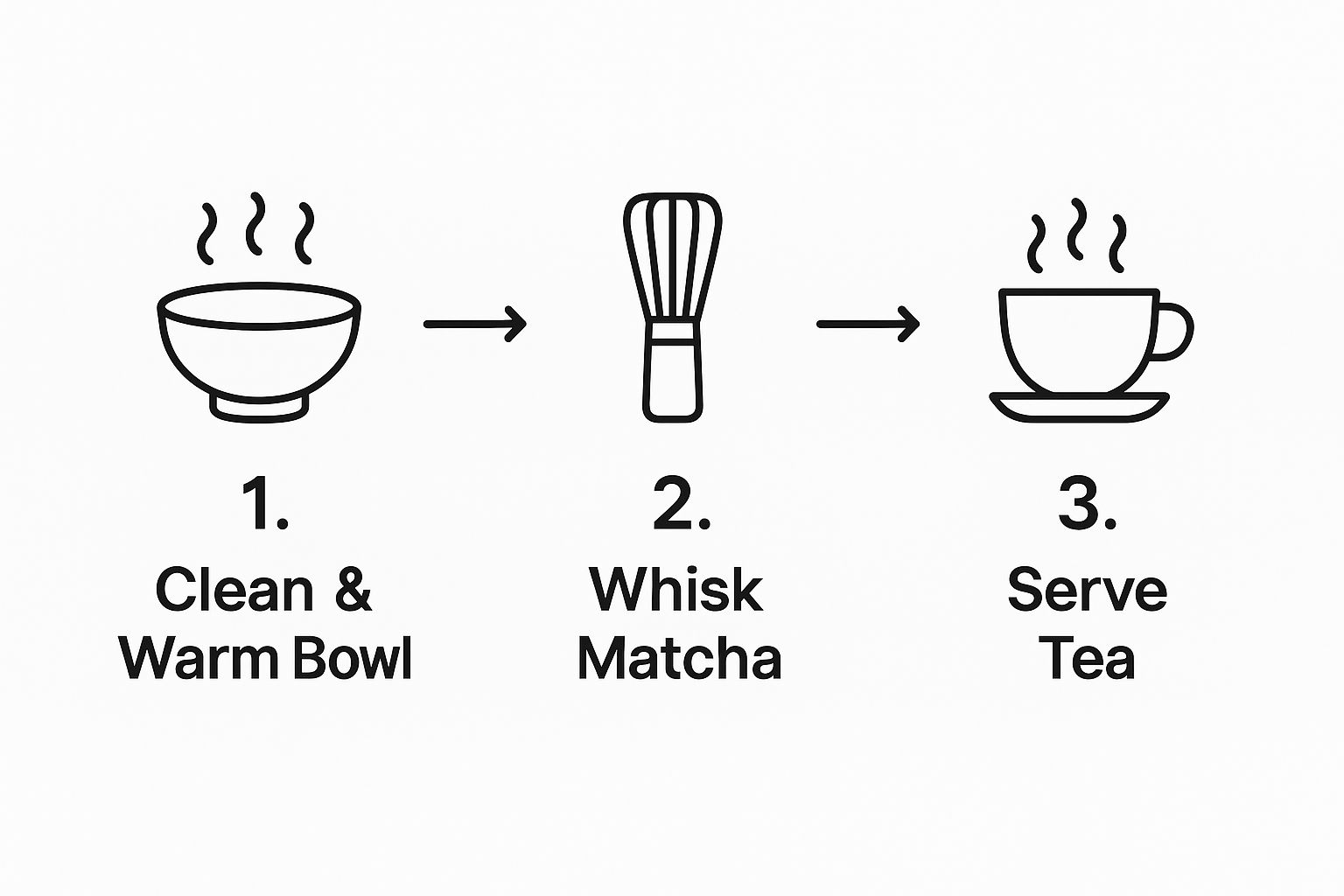
These three actions—purifying the bowl, whisking the matcha, and serving it with grace—form the very core of the host's duties. It’s how simple ingredients are transformed into a deeply shared experience.
Depending on how formal the gathering is, the type of tea served will differ.
- Koicha (Thick Tea): For more formal ceremonies, a thick, rich tea called koicha is prepared. It uses more matcha powder and less water, creating an almost syrupy consistency. A single bowl is shared among all guests, with each person taking a sip before passing it on, fostering a powerful sense of community.
- Usucha (Thin Tea): More commonly, guests are served usucha, which is a lighter, frothier tea. For usucha, each guest receives their own individual bowl. This is the style most people will encounter and is perfect for recreating a personal moment of calm at home.
Receiving and Enjoying the Tea
When a guest receives their bowl of usucha, there’s a simple yet meaningful etiquette to observe. The host presents the bowl with its most beautiful side facing the guest. In return, the guest should bow slightly in gratitude, take the bowl, and rotate it a little in their hands so they don't drink from its decorative "front."
After taking a few sips and savouring the rich flavour, it's customary to make a small slurping sound at the very end. This isn't considered rude; quite the opposite. It’s a polite signal to the host that you’ve finished and thoroughly enjoyed the tea.
The entire process, from that first step on the garden path to the final bow, is a testament to the ceremony's power to create connection and mindfulness. It’s no surprise that this profound practice is gaining appreciation far beyond Japan. Here in the UK, the traditional Japanese tea ceremony, or Sadō (茶道), has seen a remarkable rise in interest. It's estimated that over 2,000 people now participate in formal workshops each year across cities like London and Edinburgh. A 2023 survey revealed that 45% of attendees are between 30 and 50 years old, showing a mature appreciation for such cultural rituals. This interest aligns with UK consumer trends, where retail sales of high-grade green tea grew by nearly 25% between 2018 and 2023. You can read the full research about these cultural trends and their impact to see how the ceremony acts as a beautiful bridge for cultural exchange.
Choosing the Right Matcha for Your Ceremony
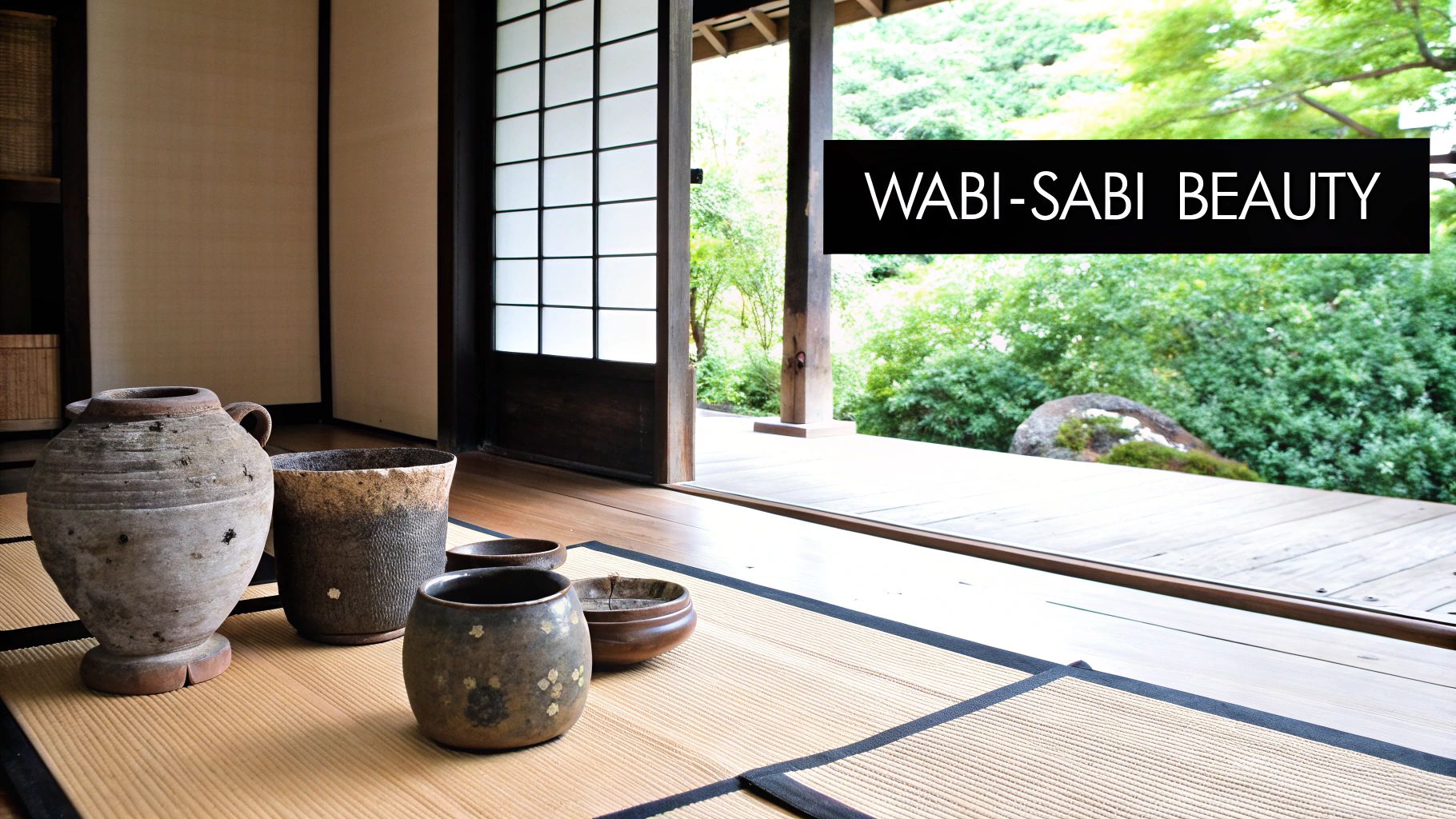
At its heart, the traditional Japanese tea ceremony is all about the matcha. The quality of the tea is the central point of the entire experience—it's the gift the host presents and the treasure the guest savours. Getting the matcha right isn't just a small detail; it's fundamental. The flavour, texture, and aroma are what define the ritual itself.
Think of it like preparing a truly exceptional meal for honoured guests. You wouldn't reach for second-rate ingredients and hope for a masterpiece. The same principle applies here, where the matcha is the main event. This is precisely why ceremonial grade matcha is the only real choice for an authentic tea ceremony.
This top-tier grade is in a different league entirely from the culinary matcha you might use for lattes or baking. Its defining qualities come from a meticulous, time-honoured process of cultivation and production, refined over centuries to create the perfect bowl of tea.
The Hallmarks of Ceremonial Grade Matcha
So, what exactly sets ceremonial grade matcha apart? It really comes down to a few key characteristics you can see, feel, and taste. The first thing you'll notice with a true ceremonial matcha is its colour—a vibrant, almost luminous green. This is a tell-tale sign of high chlorophyll content, which comes from being grown in the shade.
Next, feel the texture. It should be incredibly fine and silky, almost like talcum powder. This fineness is achieved through a slow, traditional stone-grinding process that avoids generating heat, which would otherwise spoil the tea's delicate flavour. When you open the tin, a fresh, sweet, and subtly grassy aroma should greet you.
But the taste is what truly matters most. A genuine ceremonial grade matcha is renowned for its deep, rich umami flavour—that pleasant, savoury depth—which then gives way to a smooth, mellow sweetness. Crucially, there should be a complete absence of bitterness. This complex, satisfying profile is what tea masters look for and what guests are meant to contemplate during the ceremony.
From Shade-Grown Leaf to Stone-Ground Powder
The journey to create this exceptional powder is one of incredible patience and precision. It all starts in the tea fields several weeks before the spring harvest, when the tea bushes are carefully covered to shield them from direct sunlight. This shading forces the plant to produce more chlorophyll and L-theanine, the amino acid responsible for matcha's unique calming effect and its signature umami flavour.
For the highest grades, only the youngest, most tender leaves from the very first harvest of the year, known as Ichibancha, are picked by hand. After harvesting, these precious leaves are immediately steamed to stop any oxidation, locking in their brilliant colour and nutrients. They are then painstakingly de-stemmed and de-veined to become tencha, which is the raw material for matcha. Finally, the tencha is slowly ground into an ultra-fine powder between heavy granite stone mills.
This demanding process is what transforms a simple leaf into an object of reverence, creating the quality needed for a traditional Japanese tea ceremony.
Amatsu Matcha for Your Modern and Traditional Rituals
When you understand these qualities, you can choose a matcha that truly honours the spirit of the ceremony. Amatsu Matcha is crafted with these exact principles in mind. Our Pure and Radiance ceremonial grades are made from first-harvest, stone-milled Uji tencha, making them the perfect choice for whisking up a beautiful bowl of usucha (thin tea). Their bright colour and smooth, rich flavour profile are exactly what a discerning tea practitioner would seek.
If you're inspired by the ceremony's focus on mindfulness but want to weave it into a modern wellness routine, our functional blends offer a brilliant way to do just that.
- Shrooms: This blend can help you find focus and clarity, turning your daily tea into a mindful ritual for mental performance.
- Strength: Designed with physical recovery in mind, this blend brings the ceremony’s principle of restoration into your fitness regimen.
By choosing a matcha that respects the deep traditions of the ceremony, you elevate your own daily practice. For those just starting out, our guide on how to use matcha powder effectively can help you get the basics right. Whether for a formal ceremony or a simple moment of calm, selecting the right matcha is what turns your cup into a truly purposeful experience.
Bringing the Tea Ceremony into Modern Life
https://www.youtube.com/embed/xD7qUfSOGOE
You don't need a special tea room or to train for years to embrace the heart of the traditional Japanese tea ceremony. Its wisdom isn't locked away in the past; it's a wonderfully simple way to find a moment of peace in our hectic lives. It’s all about turning the simple act of making tea into a genuine practice of presence and calm.
The core idea is to carve out a small pocket of tranquillity in your daily routine. This can be as straightforward as choosing a quiet corner in your home to be your personal tea space. Just by setting aside a specific area, you’re sending a signal to your mind that it’s time to slow down and just be.
Creating Your Daily Ritual
To get started, simply focus on your senses. Notice the vivid green of your Amatsu Matcha as you measure it into the bowl. Feel the unique texture of the bamboo whisk in your hand and listen to the gentle, rhythmic sound it makes against the ceramic. This small shift in attention turns preparing tea into a kind of moving meditation.
This modern, mindful approach to the ceremony is really catching on. In the UK, for instance, elements of the Japanese tea ceremony are now being included in wellness programmes, showing its shift from a purely cultural practice to a practical tool for mental well-being. A study from the School of Oriental and African Studies (SOAS) in London even found that people taking part in tea ceremonies reported a 24% greater sense of relaxation than those who just drank their tea casually. You can read more about the rising popularity of this practice on worldhistory.org.
Extending Hospitality and Mindfulness
The ceremony's spirit of hospitality is also incredibly easy to adopt. Sharing a freshly whisked bowl of matcha with a friend or family member is a beautiful way to practise this. It creates a space for genuine connection, away from the constant ping of our phones.
Your daily ritual doesn't need to be long or complicated. Even five minutes of focused, mindful tea preparation can reset your entire day, providing a moment of stillness that is both grounding and rejuvenating.
This practice gives you a different kind of energy, too. Instead of the jittery jolt you get from some other caffeinated drinks, the L-theanine in high-grade matcha promotes a unique state of calm alertness. For anyone looking for a more sustained focus, understanding the benefits of matcha versus coffee can be a real eye-opener.
By bringing these simple actions into your day—creating a calm space, focusing on your senses, and sharing the experience—you bring the very soul of the Japanese tea ceremony right into your own home. A daily ritual with Amatsu Matcha becomes your personal path to presence and peace.
A Few More Questions About the Tea Ceremony
Even after diving into the beautiful world of the Japanese tea ceremony, it’s completely normal to have a few lingering questions. It's a practice with incredible depth and nuance, after all. Let's clear up some of the most common queries with straightforward answers.
Do I Really Need All the Tools to Get Started?
While a full, traditional set of dōgu (tools) is a sight to behold, you absolutely don't need one to begin. To start embracing the spirit of the ceremony at home, you really only need three things: a high-quality ceremonial matcha, a bamboo whisk (chasen), and a good bowl (chawan).
What truly matters is the mindfulness and respect you bring to the process. You can cultivate this with even a very simple, thoughtfully chosen setup.
What’s the Difference Between Thick and Thin Tea?
The main distinction comes down to their consistency, the role they play in the ceremony, and the quality of matcha used.
- Koicha (Thick Tea): Think of this as the main event in a very formal ceremony. It's prepared with much more matcha and less water, giving it a rich, dense consistency, almost like warm honey. A single bowl is carefully prepared and shared among the guests, acting as a powerful symbol of unity. It requires the absolute finest grade of matcha available.
- Usucha (Thin Tea): This is a much lighter, frothier tea, and it's served in individual bowls for each guest. It’s the type you’ll most commonly encounter and is perfect for less formal gatherings or for enjoying as a personal daily ritual.
For a delicious and authentic bowl of usucha, Amatsu’s Pure or Radiance blends are fantastic choices.
What Kind of Sweets Are Served?
Traditional Japanese sweets, known as wagashi, are an essential part of the experience. Their purpose is to complement the earthy, sometimes bitter notes of the matcha, creating a beautiful balance of flavours.
You always eat the wagashi before you drink the tea. This simple act prepares your palate, allowing you to fully appreciate the complex character of the matcha without its bitterness being the first thing you notice.
What Should I Wear if I’m a Guest at a Tea Ceremony?
If you’re lucky enough to be invited to a formal ceremony, your attire is a way of showing respect for your host and the occasion. The key is to be modest and conservative.
For men, a dark suit is a safe and appropriate choice. For women, a modest dress or, if you have one, a kimono is ideal. It’s also very important to avoid wearing strong perfumes or any jewellery—especially rings, which could accidentally scratch the precious, often antique, tea bowls. The idea is to add to the quiet harmony of the event, not detract from it.
Ready to start your own mindful tea ritual? The journey begins with the perfect matcha. Explore the exceptional quality of Amatsu Matcha, sourced directly from Uji and stone-milled for an authentic experience. Discover our full range of ceremonial and functional blends today.
Read more
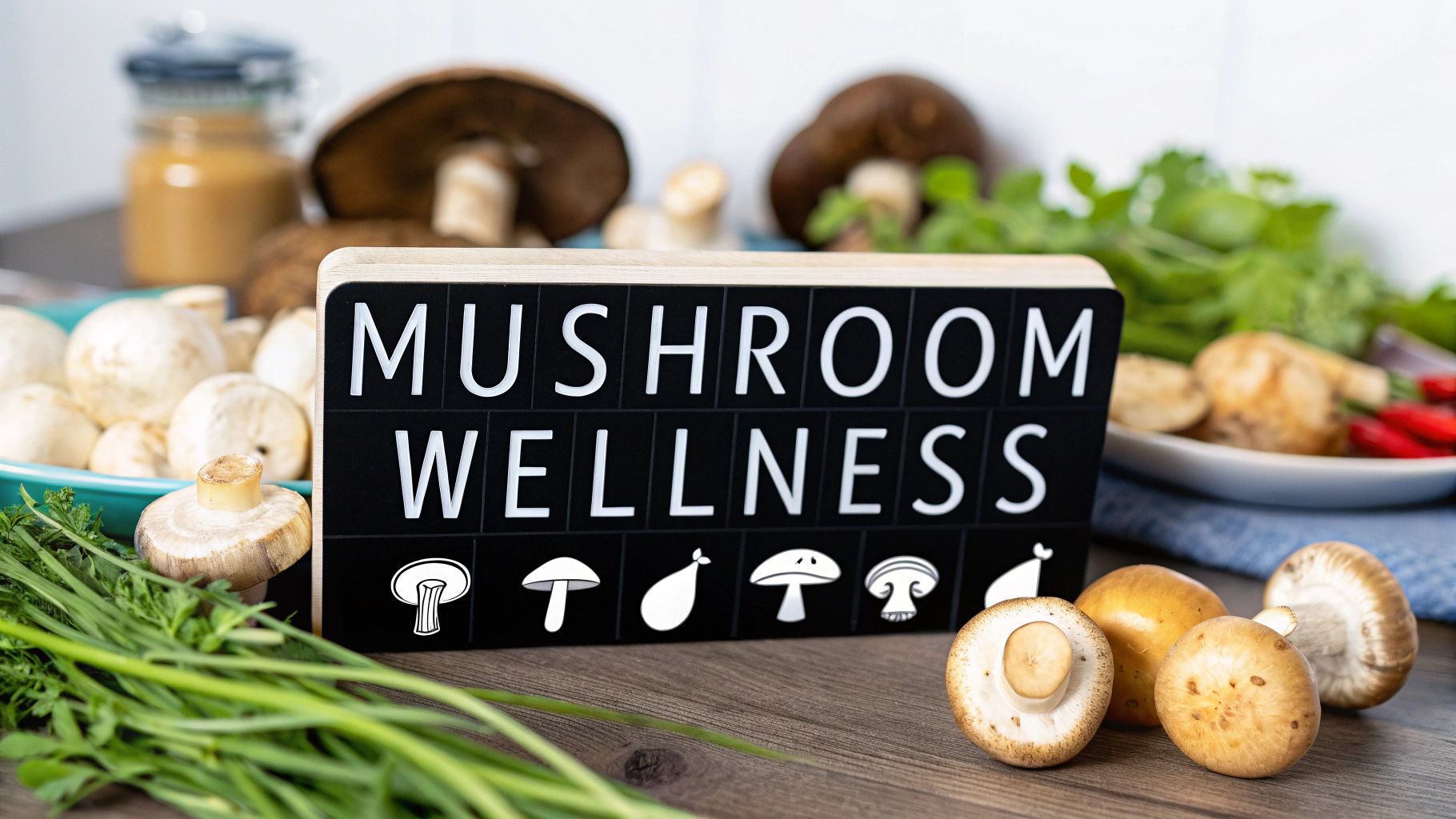
Discover the key mushroom benefits for women. This guide explores how functional fungi like Reishi & Lion's Mane support hormones, energy, and cognitive health.
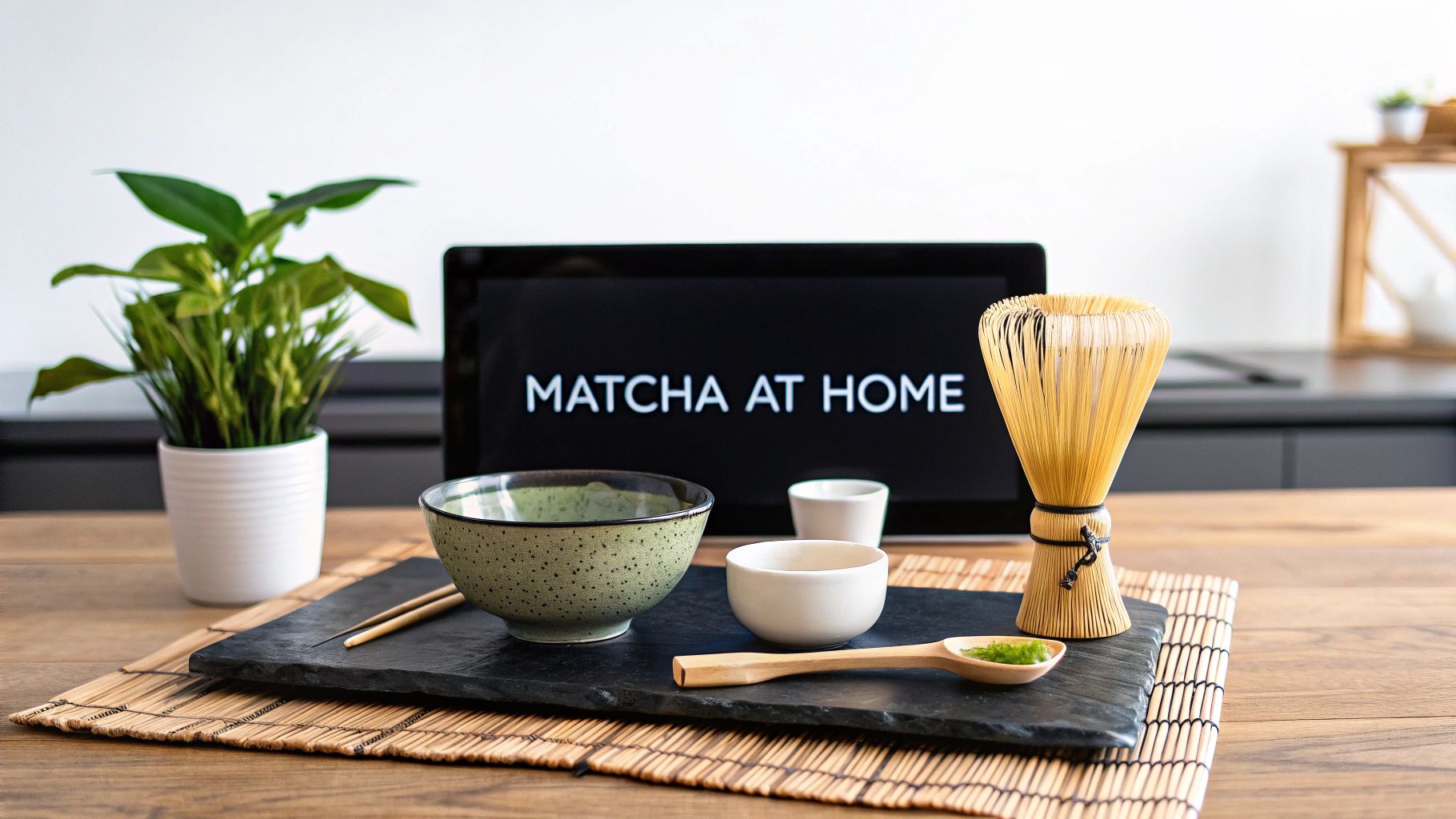
Create an authentic tea ceremony matcha experience at home. Our guide covers essential tools, techniques, and the best matcha for a mindful, perfect cup.
